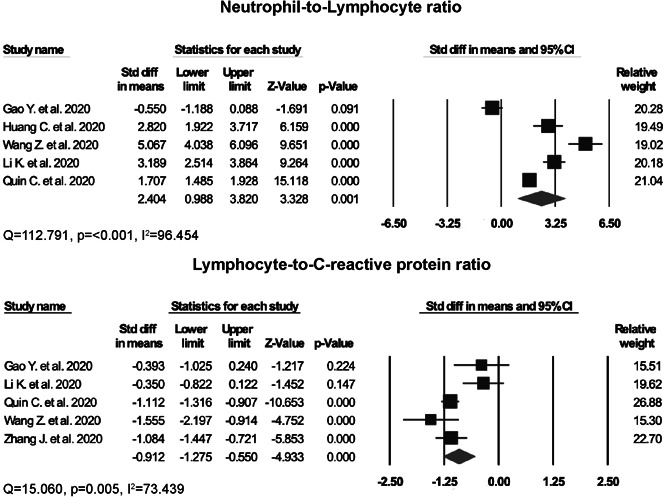To the Editor,
Since March 11, 2020, the World Health Organization defined coronavirus disease 2019 (COVID‐19) as a pandemic, with a series of confirmed cases that currently exceeded 300,000 people worldwide and with approximately 14,500 deaths. 1 Accumulated evidence suggests that a subgroup of patients with severe COVID‐19 could have a dysregulation of the immune response that allows the development of viral hyperinflammation. 2 Thus, all patients with severe COVID‐19 should be screened for hyperinflammation using laboratory parameters to improve mortality. Neutrophil‐to‐lymphocyte ratio (NLR) and lymphocyte‐to‐C‐reactive protein ratio (LCR) are established inflammation markers that reflect systemic inflammatory response, 3 , 4 and both are available in almost all laboratories. In this study, a meta‐analysis was performed to investigate whether NLR and LCR values can help predict clinical severity in patients with COVID‐19.
First, we conducted an electronic search in different search engines that included Medline (PubMed interface), Scopus, Web of Science via Raven and Google Scholar, using the keywords “Severe 2019‐nCoV” OR "Severe COVID‐19" without date (i.e. until March 23, 2020) or language restrictions. The title, abstract, and full text of all the articles identified according to these search criteria were analyzed, considering for our meta‐analysis only those that reported data in COVID‐19 patients with or without severe disease (defined as severe or with the need to enter the intensive care unit or the use of mechanical ventilation).
Six studies were included in our meta‐analysis, four of them allowed us to calculate both NLR and LCR. The other two articles, one was considered only for NLR calculations and the other only for LCR calculations. Mean and standard deviation were extrapolated from the median, range, and sample size according to Hozo et al. 5 For NLR, the number of neutrophils and lymphocytes was taken per 109/L, while LCR was calculated as follows: lymphocyte count (number/μL)/C‐reactive protein (mg/dL). Meta‐analysis was performed using Comprehensive Meta‐Analysis Software version 3 (2013, Biostat, Englewood, NJ) calculating the standardized mean difference (SMD) and the 95% confidence interval (95% CI) of the NLR and LCR values in patients with COVID‐19 with or without severe disease.
All the studies were carried out in China and included a total number of 828 patients, where 407 patients had severe disease (49.15%) and the sample size varied between 41 and 452 patients. The SMD of the five studies used for each parameter is summarized in Figure 1. Since heterogeneity (I2 statistics) exceeded 50% in both meta‐analyses, a random effects model was used. The NLR values were found to increase significantly in patients with COVID‐19 with severe disease (SMD = 2.404, 95% CI = 0.98‐3.82), while LCR values were decreased significantly (SMD = −0.912, 95% CI = −1.275 to −0.550).
Figure 1.

Standardized mean difference (SMD) and 95% confidence interval (95% CI) of neutrophil‐to‐lymphocyte ratio and lymphocyte‐to‐C‐reactive protein ratio in coronavirus disease 2019 (COVID‐19) patients with or without severe disease
Despite several reports describing increased levels of neutrophils and C‐reactive protein along with a decrease in lymphocyte numbers in patients with COVID‐19, 2 , 6 , 7 , 8 , 9 , 10 until now, very few reports have considered the cost‐effective markers NLR and LCR to aid complication predictions. Acute respiratory distress syndrome, which is a type of respiratory failure characterized by a rapid onset of generalized inflammation in the lungs, is the leading cause of mortality of patients with COVID‐19. Thus, increased NLR levels and low LCR levels reflecting an enhanced inflammatory process may suggest a poor prognosis.
CONFLICT OF INTERESTS
The author declares that there is no conflict of interests.
ACKNOWLEDGMENTS
FALR is recipient of a doctoral scholarship (Application number 2018‐000012‐01NACF‐07226) from the National Council of Science and Technology, CONACyT.
REFERENCES
- 1. Coronavirus Disease 2019 (COVID‐19) Situation Report‐63 . Accessed March 24, 2020. https://www.who.int/docs/default‐source/coronaviruse/situation‐reports/20200323‐sitrep‐63‐covid‐19.pdf?sfvrsn=b617302d_2
- 2. Qin C, Zhou L, Hu Z, et al. Dysregulation of immune response in patients with COVID‐19 in Wuhan, China. Intergovernmental Panel on Climate Change, ed. Clin Infect Dis. 2020;53(9):1‐30. 10.1093/cid/ciaa248 [DOI] [PMC free article] [PubMed] [Google Scholar]
- 3. Meng L‐B, Yu Z‐M, Guo P, et al. Neutrophils and neutrophil‐lymphocyte ratio: inflammatory markers associated with intimal‐media thickness of atherosclerosis. Thromb Res. 2018;170(May):45‐52. 10.1016/j.thromres.2018.08.002 [DOI] [PubMed] [Google Scholar]
- 4. Okugawa Y, Toiyama Y, Yamamoto A, et al. Lymphocyte‐C‐reactive protein ratio as promising new marker for predicting surgical and oncological outcomes in colorectal cancer. Ann Surg. 2019. 10.1097/SLA.0000000000003239 [DOI] [PubMed] [Google Scholar]
- 5. Hozo SP, Djulbegovic B, Hozo I. Estimating the mean and variance from the median, range, and the size of a sample. BMC Med Res Methodol. 2005;5(1):13. 10.1186/1471-2288-5-13 [DOI] [PMC free article] [PubMed] [Google Scholar]
- 6. Huang C, Wang Y, Li X, et al. Clinical features of patients infected with 2019 novel coronavirus in Wuhan, China. Lancet. 2020;395(10223):497‐506. 10.1016/S0140-6736(20)30183-5 [DOI] [PMC free article] [PubMed] [Google Scholar]
- 7. Wang Z, Yang B, Li Q, Wen L, Zhang R. Clinical features of 69 cases with coronavirus disease 2019 in Wuhan, China. Clin Infect Dis. 2020. 10.1093/cid/ciaa272 [DOI] [PMC free article] [PubMed] [Google Scholar]
- 8. Zhang J, Dong X, Cao Y, et al. Clinical characteristics of 140 patients infected with SARS‐CoV‐2 in Wuhan, China. Allergy. 2020. 10.1111/all.14238 [DOI] [PubMed] [Google Scholar]
- 9. Gao Y, Li T, Han M, et al. Diagnostic utility of clinical laboratory data determinations for patients with the severe COVID‐19. J Med Virol. 2020. 10.1002/jmv.25770 [DOI] [PMC free article] [PubMed] [Google Scholar]
- 10. Li K, Wu J, Wu F, et al. The clinical and chest CT features associated with severe and critical COVID‐19 pneumonia. Invest Radiol. 2020. 10.1097/RLI.0000000000000672 [DOI] [PMC free article] [PubMed] [Google Scholar]


